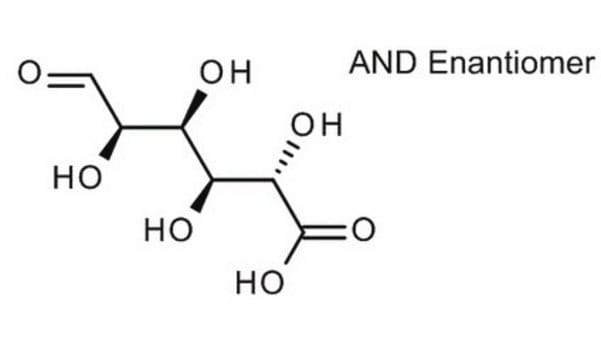This product is prepared from the Gluconic acid and not a potassium or sodium salt form. While trace analysis testing is not performed on this material, no potassium or sodium has been added during the manufacturing process.
Wichtige Dokumente
G1951
D-Gluconsäure -Lösung
49-53 wt. % in H2O
Synonym(e):
2,3,4,5,6-Pentahydroxycapronsäure
Größe auswählen
Größe auswählen
About This Item
Empfohlene Produkte
Form
viscous liquid
Qualitätsniveau
Optische Aktivität
[α]/D +9.0 to 15.5°
Konzentration
49-53 wt. % in H2O
Brechungsindex
n20/D 1.4161
Dichte
1.234 g/mL at 25 °C
SMILES String
OC[C@@H](O)[C@@H](O)[C@H](O)[C@@H](O)C(O)=O
InChI
1S/C6H12O7/c7-1-2(8)3(9)4(10)5(11)6(12)13/h2-5,7-11H,1H2,(H,12,13)/t2-,3-,4+,5-/m1/s1
InChIKey
RGHNJXZEOKUKBD-SQOUGZDYSA-N
Suchen Sie nach ähnlichen Produkten? Aufrufen Leitfaden zum Produktvergleich
Anwendung
used in hygienic products, food and pharmaceutical industry.[2]
Lagerklassenschlüssel
10 - Combustible liquids
WGK
WGK 1
Flammpunkt (°F)
Not applicable
Flammpunkt (°C)
Not applicable
Persönliche Schutzausrüstung
Faceshields, Gloves, Goggles, type ABEK (EN14387) respirator filter
Hier finden Sie alle aktuellen Versionen:
Besitzen Sie dieses Produkt bereits?
In der Dokumentenbibliothek finden Sie die Dokumentation zu den Produkten, die Sie kürzlich erworben haben.
Kunden haben sich ebenfalls angesehen
-
Does this product contain potassium or sodium as a component?
1 answer-
Helpful?
-
-
How can I determine the shelf life / expiration / retest date of this product?
1 answer-
If this product has an expiration or retest date, it will be shown on the Certificate of Analysis (COA, CofA). If there is no retest or expiration date listed on the product's COA, we do not have suitable stability data to determine a shelf life. For these products, the only date on the COA will be the release date; a retest, expiration, or use-by-date will not be displayed.
For all products, we recommend handling per defined conditions as printed in our product literature and website product descriptions. We recommend that products should be routinely inspected by customers to ensure they perform as expected.
For products without retest or expiration dates, our standard warranty of 1 year from the date of shipment is applicable.
For more information, please refer to the Product Dating Information document: https://www.sigmaaldrich.com/deepweb/assets/sigmaaldrich/marketing/global/documents/449/386/product-dating-information-mk.pdfHelpful?
-
-
How is shipping temperature determined? And how is it related to the product storage temperature?
1 answer-
Products may be shipped at a different temperature than the recommended long-term storage temperature. If the product quality is sensitive to short-term exposure to conditions other than the recommended long-term storage, it will be shipped on wet or dry-ice. If the product quality is NOT affected by short-term exposure to conditions other than the recommended long-term storage, it will be shipped at ambient temperature. As shipping routes are configured for minimum transit times, shipping at ambient temperature helps control shipping costs for our customers. For more information, please refer to the Storage and Transport Conditions document: https://www.sigmaaldrich.com/deepweb/assets/sigmaaldrich/marketing/global/documents/316/622/storage-transport-conditions-mk.pdf
Helpful?
-
-
WHAT is the ppm of the solution in 100ml
1 answer-
The concentration of this product may range from 49% - 53%. The calculated ppm value will range from 490,000 - 530,000.
Helpful?
-
-
Hi what is the molarity of the solution provided? 25g in 50%wt solution
1 answer-
At exactly 50% the molarity of this solution is 3.14M. The molarity may be calculated using the following equation below:
Molarity (moles/L) = Density (g/L) ÷ Molecular Weight (g/mol) * purity
= 1234g/L ÷ 196.16 g/mol * 0.50
= 3.14539MThe concentration of this product ranges from 49 - 53% and may change slightly from lot to lot. Please see the link below to access a sample or specific lot Certificate of Analysis:
https://www.sigmaaldrich.com/product/aldrich/g1951#product-documentationHelpful?
-
Active Filters
Unser Team von Wissenschaftlern verfügt über Erfahrung in allen Forschungsbereichen einschließlich Life Science, Materialwissenschaften, chemischer Synthese, Chromatographie, Analytik und vielen mehr..
Setzen Sie sich mit dem technischen Dienst in Verbindung.











